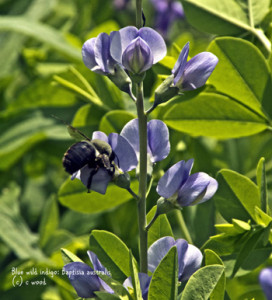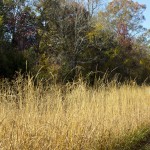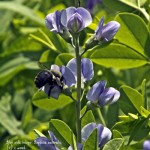Location: Prince Edward County Virginia Cooperative Extension Office – 100 Dominion Drive, Farmville, VA 23901
Demonstration Garden

Have you heard about BayScaping? It’s a low-input approach to landscaping that generally requires the use of less fertilizer and fewer pesticides, not to mention less mowing, because it emphasizes the use of native plants that are uniquely suited to local growing conditions. It also emphasizes conservation through the conversion of lawns to meadows or gardens and use of rain gardens or rain barrels to help reduce water runoff during storms. BayScaping can save time, energy, and money while also protecting streams, rivers, and the waters of the Chesapeake Bay.
Our BayScape garden was started in 2001 with a grant from the Chesapeake Bay Restoration Fund. The Piedmont Soil and Water Conservation District coordinated the project and partnered with Prince Edward County, the Virginia Department of Forestry, the Virginia Department of Game and Inland Fisheries, the United States Department of Agriculture, the Natural Resources Conservation Service, and Virginia Cooperative Extension. The Heart of Virginia Master Gardeners maintain the garden and use it to demonstrate good gardening practices.
The BayScape garden contains a wide variety of native plants that would be suitable for many home gardens in our area. There are four native trees:
- Alleghany serviceberry, Amelanchier laevis: Early spring bloomer with berries that attract birds
- Fringe tree, Chionanthus virginicus: A small tree with fragrant, white, fringe-like spring blooms
- River birch, Betula nigra, ‘Heritage:’ Ornamental, deciduous tree with attractive exfoliating bark
- Serviceberry, Amelanchier grandiflora, ‘Autumn Brilliance:’ A large shrub or small tree that offers garden interest in all seasons. Beautiful white blooms in early spring.
There is only one vine in the garden, but in early to mid spring, it’s a show stopper. Crossvine, Bignonia capreolata has beautiful showy red-yellow trumpet-shaped blooms and grows well in full sun to partial shade.
Interspersed throughout the garden are many different shrubs, including:
- Arrowood viburnum, Viburnum dentatum: A 6 to 8 foot tall shrub with clusters of white spring flowers followed by dark blue fruit that’s attractive to birds. Leaves turn yellow to deep red in fall.
- Beautyberry, Callicarpa americana: Another relatively small shrub with small white flowers and metallic purple berries in fall.
Buttonbush, Cephalanthus occidentalis: Deciduous shrub with fragrant white flowers that attract bees and butterflies. - Inkberry, Ilex glabra, ‘Shamrock:’ Dark purple berries that attract birds.
- Oak-leaf hydrangea, Hydrangea quercifolia: Provides year-round interest — white blooms in early summer that provide nectar and interesting bark in winter.
- Pepperbush, Clethra alnifolia, ‘Hummingbird:’ Fragrant white blooms in July that attract bees and butterflies.
- Rhododendron, Rhododendron maximum: Light pink spring blooms that are a nectar source. Leathery evergreen foliage.
- Spice bush, Lindera benzoin: Yellow blooms in early spring followed by red berries that attract birds.
- Virginia sweetspire, Itea virginica,’Henry’s Garnet:’ Fragrant white blooms in May-June; a nectar source.
- Winterberry, Ilex verticillata, ‘Winter Red:’ Deciduous shrub with red berries that attract birds.
- Witch hazel, Hamemelis virginiana: Fragrant yellow blooms in late winter; a good nectar source.
- Yaupon holly, Ilex vomitoria, “Schillings” Low, slow-growing evergreen shrub. This holly doesn’t have any berries or spines.


If you’re interested in perennials and native grasses, there are numerous examples of these in the garden too. Some recently added perennials include: Bee balm (Monarda didyma), Black-eyed Susan (Rudbeckia fulgida), Blazing star (Liatris spicata), Butterflyweed (Asclepias tuberosa), Purple coneflower (Echinacea purpurea), Threadleaf coreopsis (Coreopsis verticilliata), Solomon’s seal (Polygonatum biflorum), Wild columbine (Aquilegia canadensis), field pussytoes (Antennaria neglecta), turk’s cap lily (Lilium superbum), Coral bells (Heuchera americana), mayapple (Podophyllum peltatum), Virginia blue flag (Iris virginica), cardinal flower (Lobelia cardenalis), Wild geranium (Geranium maculatum), large flowered trillium (Trillium grandiflorum), Wild ginger (Asarum canadense), Woodland phlox (Phlox divaricata), Virginia bluebells (Mertensia virginica), and foxglove beardtongue (Penstemon spp.).
Native grasses in the garden provide food and nesting areas for game birds and other wildlife. There are four native grasses: switchgrass (Panicum virgatum), Indian grass (Sorghastrum nutans), big bluestem (Andropogon gerardii), and little bluestem (Andropogon scoparius).
We’ve also added Christmas ferns (Polystichum acrostichoides) for year round color.
The BayScape garden is located around the building housing the Prince Edward County offices of the Virginia Cooperative Extension and the Piedmont Soil and Water Conservation District at 100 Dominion Drive in Farmville, Virginia and is open to the public.
Please stop by for a visit. Questions? Contact Deanna Fehrer: dfehrer@piedmontswcd.org
